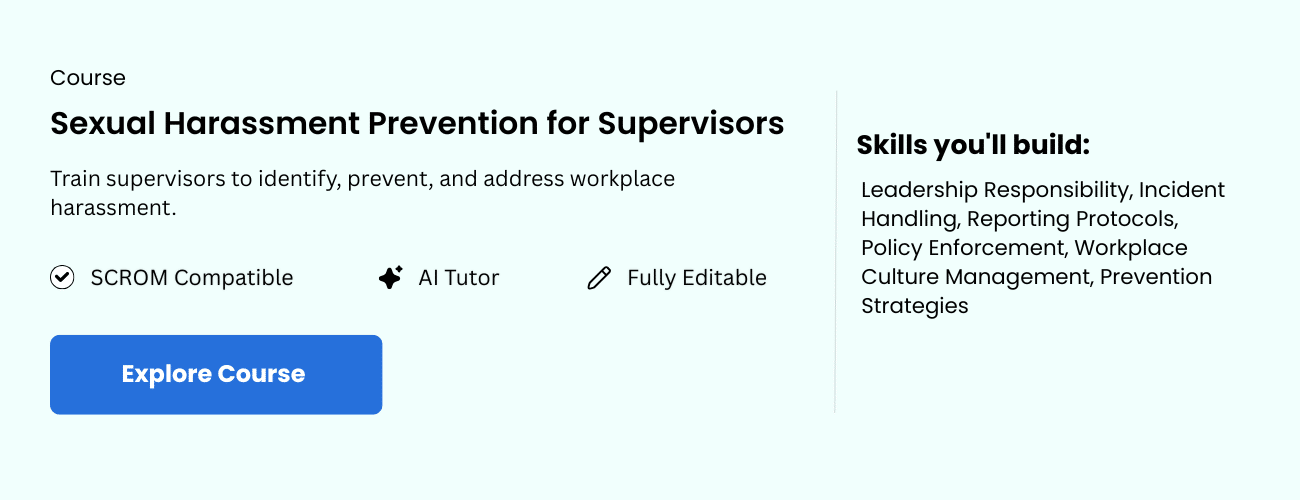Legal Framework in New York Regarding Workplace Harassment
Creating a safe and respectful work environment is a primary obligation for employers under New York law. The state has one of the strongest and most comprehensive legal frameworks in the U.S. to address and prevent workplace harassment. New York’s regulations go beyond federal standards, emphasizing proactive measures, clear employer responsibilities, and continuous compliance to protect all employees.
Under the New York State Human Rights Law (NYSHRL) and the New York State Sexual Harassment Prevention laws, every employer regardless of size must implement strict anti-harassment policies, provide annual training, and maintain transparent reporting processes. This includes mandatory Sexual Harassment Prevention for Supervisors, ensuring leaders understand their heightened responsibilities in recognizing, addressing, and preventing misconduct before it escalates.
These laws require employers to offer interactive, accessible Sexual Harassment Prevention Training, aligned with state-issued model standards. Supervisors, in particular, must be equipped to handle complaints properly, document issues, and support employees without bias or retaliation.
Recent legislative updates have further strengthened protections by expanding the definition of harassment, lowering the threshold for proving misconduct, and improving whistleblower safeguards. Employers must also share written policies at hiring, post required notices, and ensure reporting procedures are easy, confidential, and retaliation-free.
Employer and Supervisor Obligations Under New York Law
In New York, employers must actively prevent harassment by implementing comprehensive policies and providing regular training. The New York State Human Rights Law (NYSHRL) prohibits employment discrimination and harassment based on protected characteristics such as race, gender, age, and sexual orientation. Employers are required to disseminate anti-harassment policies and ensure all employees and management participate in training programs.
Supervisors have an increased responsibility to recognize, prevent, and address harassment swiftly. They are expected to investigate complaints thoroughly and enforce appropriate disciplinary actions. Failing to meet these obligations can lead to legal liabilities, fines, and damage to reputation.
Recent Legislative Updates and Their Significance
New York has enacted several legal changes to enhance workplace harassment protections. The Stop Sexual Harassment in Employment Act of 2019 expanded reporting requirements and clarified employer responsibilities. It mandates comprehensive anti-harassment policies, mandatory annual training, and clear procedures for filing complaints.
In 2022, legislation increased penalties for violations and broadened coverage to include interns and certain independent contractors. The Gender Expression and Identity Law underscores the importance of respecting gender identities, reinforcing anti-discrimination protections across workplaces.
These updates close existing gaps, ensure organizations remain compliant, and foster inclusive, respectful work environments. They also play a vital role in educating employees about their rights and available avenues for reporting misconduct.
The Importance of Compliance and a Respectful Work Environment
Adhering to New York’s legal mandates is essential for more than legal compliance—it helps build a workplace culture rooted in respect and dignity. Effective compliance reduces the risk of costly litigation, boosts employee morale, and enhances the organization’s reputation.
Proactive policies and ongoing training promote an environment where employees feel safe reporting concerns early. This helps prevent issues from escalating and fosters trust. The legal framework reflects a societal shift toward zero tolerance for harassment, highlighting the need for continuous education, transparent procedures, and committed leadership.
By understanding and implementing these legal requirements, employers can create a healthy, respectful, and compliant work environment aligned with New York’s evolving standards.

Enhancing Workplace Culture Through Effective Sexual Harassment Training: Best Practices for Supervisors in New York
Creating a safe, respectful workplace is vital for organizational success and employee well-being. Effective sexual harassment training New York programs play a crucial role by educating employees and supervisors on appropriate behavior, legal requirements, and company policies. In a state where laws are among the strictest in the nation, comprehensive training is essential not just for compliance, but for building a culture of accountability and trust.
New York mandates annual, interactive training for all staff, emphasizing the importance of recognizing, preventing, and reporting misconduct. This includes specialized Sexual Harassment Prevention for Supervisors, ensuring leaders fully understand their heightened responsibilities—such as responding promptly to complaints, documenting incidents accurately, guiding employees through reporting procedures, and preventing retaliation. These supervisor-focused modules strengthen an organization’s ability to maintain safe, transparent, and harassment-free workplaces.
The Impact of Sexual Harassment Training on Workplace Culture
Comprehensive training helps cultivate a culture of respect and dignity. When employees understand what constitutes inappropriate conduct, they are more likely to interact respectfully and report misconduct early. This proactive approach reduces harassment incidents and builds trust, leading to higher employee engagement and retention.
Legal and Liability Reduction Benefits
Under the New York State Human Rights Law, employers must provide sexual harassment prevention training. Non-compliance can lead to legal penalties, lawsuits, and damage to reputation. Well-designed programs inform employees and supervisors of their rights and responsibilities, demonstrating an organization’s commitment to a harassment-free workplace and reducing potential liabilities.
Best Practices for Supervisors to Implement Impactful Training Programs
Supervisors are essential in embedding harassment prevention into workplace culture. Here are key best practices:
1. Develop Clear and Engaging Content
Create training materials that are comprehensive, current, and tailored to your industry. Incorporate real-world scenarios relevant to your field in New York to illustrate key points effectively.
2. Make Training Interactive and Accessible
Enhance understanding through workshops, role-playing exercises, and simulation activities. Offer multiple formats such as in-person sessions or online modules to accommodate diverse learning styles.
3. Foster an Open Dialogue Culture
Encourage questions, honest discussions, and sharing of experiences. Leadership should model respectful communication and demonstrate zero tolerance for harassment.
4. Reinforce Ongoing Education and Policies
Conduct regular refresher courses and policy updates to keep awareness high. Provide clear procedures for reporting misconduct and protect whistleblowers effectively.
5. Measure and Improve Training Effectiveness
Collect feedback through surveys and track incident reports to evaluate program impact. Use insights gained to refine content and delivery methods continuously.

Key Topics and Methods for Comprehensive Training Aligned with New York State Requirements and Industry Standards
An effective training program must balance legal compliance with practical skill development. Combining targeted topics and dynamic instructional methods ensures personnel are well-prepared, compliant, and professional.
Essential Topics in Training Programs
Core topics should be industry-specific and role-oriented, including:
- Regulatory Compliance: Understanding state laws, licensing, and regulations to meet legal standards.
- Safety Procedures: Incorporating OSHA standards and safety protocols to reduce workplace hazards.
- Technical Skills: Practical knowledge related to specific job functions, equipment handling, or service methods.
- Customer Service & Communication: Improving interpersonal skills for better client and team interactions.
- Ethics & Professionalism: Promoting integrity, confidentiality, and responsible conduct aligned with industry norms.
Effective Methods for Training Delivery
Diverse training approaches enhance learning and retention:
- Role-Playing Exercises: Simulate real situations like handling difficult clients or safety emergencies to develop practical responses.
- Scenario-Based Learning: Complex situations that require analysis, judgment, and application of regulations encourage critical thinking.
- Interactive Workshops: Group activities and discussions foster engagement and operational understanding.
- E-Learning Modules: Flexible online courses allow self-paced learning, easily updated for new standards.
- Assessments & Quizzes: Regular evaluations measure understanding and reinforce key concepts.
Aligning Training with Requirements & Standards
Integrating relevant topics with engaging methods ensures compliance training with New York state laws and industry standards. Periodic review and updates, along with practical exercises like scenario simulations, cultivate a capable, compliant workforce ready to meet operational challenges.
Strategies for Ongoing Education, Proactive Harassment Prevention, and Resource Utilization for Supervisors
Leadership success depends on continuous learning, proactive harassment prevention, and effective use of resources. Supervisors play a key role in maintaining a respectful, inclusive environment that complies with legal and organizational standards.
Continuous Education for Supervisors
Stay current through regular webinars, workshops, and courses covering diversity, equity, and inclusion topics, legal updates, and best practices. Consistent learning improves supervisors’ ability to manage misconduct and supports employee engagement. Implementing quarterly training schedules helps sustain knowledge and competence.
Proactive Harassment Prevention Strategies
Preventive measures start with clear policies and immediate response to concerns. Regular communication, training, and an open-door policy empower employees to report issues early. Bystander intervention training and awareness campaigns further enhance prevention efforts, reducing harassment incidents and fostering trust.
Utilizing Resources Effectively
Leverage internal resources such as HR teams, legal counsel, and Employee Assistance Programs, along with external tools like anonymous reporting apps and specialized training platforms. Regular staff climate assessments and audits help identify improvement areas and measure program success. Proper resource utilization ensures legal compliance and reinforces accountability.
Building a Culture of Respect and Accountability
Model respectful behavior consistently and recognize positive conduct to strengthen organizational values. Regular feedback through surveys and performance reviews helps gauge workplace culture and guides ongoing improvement initiatives. Combining ongoing education, proactive policies, and resource use creates a safe, inclusive environment where respect and accountability thrive.
Why Sexual Harassment Training Is Crucial for Supervisors: Promoting Accountability and Continuous Learning
Empowering supervisors with sexual harassment training is fundamental to fostering accountability and cultivating a respectful workplace. Such training clarifies legal and ethical responsibilities, provides practical tools for handling issues, and emphasizes the importance of immediate action when problems arise.
Ongoing education keeps supervisors vigilant about evolving laws, societal expectations, and best practices. This helps maintain a proactive stance in preventing harassment. When leaders understand their critical role, they create an environment where employees feel safe to report concerns without fear of retaliation.
Investing in comprehensive training demonstrates organizational commitment to zero tolerance of harassment, reduces legal risks, and promotes a healthier, more inclusive workplace. Active supervisor engagement through continuous learning and accountability is essential for ongoing organizational integrity and employee well-being.











